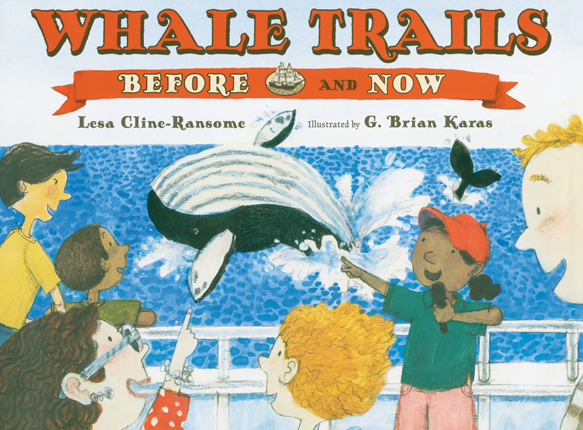| Whale trails, before and now Author: Cline-Ransome, Lesa | ||
| Price: $22.58 | ||
Summary:
A young girl helps her father, the captain of a whale boat, on a whale-watching trip and relates how her ancestors hunted whales in the same waters. Includes information on the history of whaling, whale-watching, and the conservation movement to ensure the safety of whales.
| Illustrator: | Karas, G. Brian |
| Accelerated Reader Information: Interest Level: LG Reading Level: 6.20 Points: .5 Quiz: 174269 |
Reviews:
Kirkus Reviews (+) (11/01/14)
School Library Journal (11/01/14)
Booklist (12/15/14)
The Bulletin of the Center for Children's Books (04/15)
Full Text Reviews:
School Library Journal - 11/01/2014 Gr 1–3—A young girl and her father are first mate and captain, respectively, on a family-owned whale-watching vessel, the Cuffee. She explains that prior generations of her family were whalers. From that point on, the story moves back and forth between the past and present. "Before now," the girl says, "children were taught whales were dangerous sea creatures that devoured our fish supply and were good only for their baleen and blubber." Now, passengers view pictures of the whales that they might see on daily sightseeing trips. In the old days, whalers left in the summer and hunted whales in warmer waters. Nowadays, passengers "set sail…when the weather cools and the whales are everywhere feeding on copepods, sand lance, and krill." In the past, "this pier was lined with shops of shipbuilders, candle makers, blacksmiths, and sail makers." Today, the pier by the dock "is lined with booths that sell souvenirs, sunglasses, binoculars, and sunscreen." The book further explains the various tools whalers used, their life on board ship, and the products harvested from captured whales. Karas effectively contrasts past and present, using sepia tones for depictions of the olden times and colorful gouache and acrylic images for portrayals of current times. Endnotes include a short glossary and further information on the whaling industry and international efforts to protect whales.—Roxanne Burg, Orange County Public Library, CA - Copyright 2014 Publishers Weekly, Library Journal and/or School Library Journal used with permission.
Booklist - 12/15/2014 “My father and I live for the sea,” begins this picture book, in which an African American girl and her father carry on a family tradition of looking for whales. Today, they take passengers out on their whale-watch boat. In the old days, their ancestors crewed ships that hunted whales. Narrated by the girl, the text on one side of each spread tells of the whale-watch boat, on which she is her father’s first mate. On the facing page, she tells of life aboard a New England whaling ship perhaps 200 years ago. Each narrative line climaxes with a whale sighting, though the outcomes are very different. An interesting author’s note is appended. In gouache, acrylic, and pencil artwork, Karas offers engaging illustrations of both time periods. Depicting scenes at sea and along the dock, the paintings of modern times use full color, while the related scenes set in bygone days are limited to sepia tones and black. The contrast is quite effective. A captivating and informative picture book with an intriguing dual focus. - Copyright 2014 Booklist.
Bulletin for the Center... - 04/01/2015 A little girl joins her father aboard his boat, the Cuffee, which takes tourists out for a day of whale-watching. She explains the family business, comparing it to the early days of commercial whaling, with full-color pictures on the verso of each spread and sepia illustrations on the recto (“The pier where our boat is docked is lined with booths that sell souvenirs, sunglasses, binoculars, and sunscreen”; “Before now, this pier was lined with the shops of shipbuilders, candle makers, blacksmiths, and sail makers”). The tourists’ excitement upon first seeing a whale breach contrasts vividly with the moment in times past when the whalers shared the same sight and began their chase; double-page spreads for these scenes mark the climax of parallel adventures. The narrator clearly loves the family business, which allows respectful whale viewing from a safe distance, but she isn’t sternly judgmental about whale hunting in the past; in fact, she takes pride in the fact that she is a descendant of generations of African-American whalers. Karas’ pictures are not only engaging but packed with visual information that effortlessly supplements the text. Endnotes, complete with a glossary and a half dozen resources for further investigation, expand on the whaling industry (with a nod to critique of well-meaning eco-tourism, which may be interrupting whales’ behavior) and remark on black abolitionist and whaler Paul Cuffee, for whom the fictional tour boat is named. EB - Copyright 2015 The Board of Trustees of the University of Illinois.



